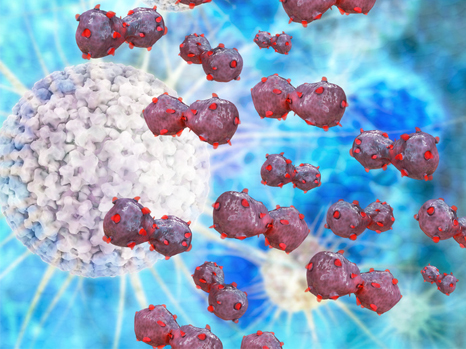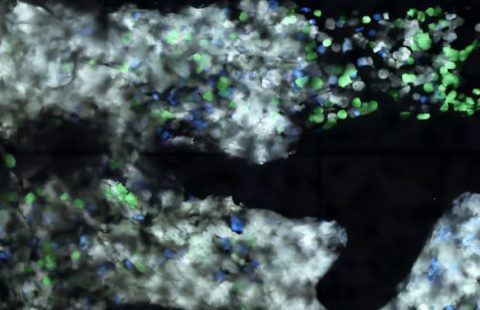A joint Institut Curie/Inserm team headed by Dr. Olivier Delattre has discovered the existence of a new form of bone sarcoma, affecting mainly adolescents and young adults.
Although similarities exist with Ewing’s tumor in the clinical field, a different chromosomal abnormality is responsible for the development of this sarcoma.
This new information should enable to improve patient management.
The results of this discovery have been published online in Nature Genetics on March 4.
Institut Curie is the French center of excellence for the detection and clinical management of Ewing’s tumors, performing the majority of molecular diagnostic tests for this pathology. The team of Olivier Delattre, research director of Inserm 830/Institut Curie “Genetics and Biology of Cancers” unit, was thus able to examine the genetic material of 594 children suspected to have Ewing’s tumor. Using a new sequencing technology called Next generation sequencing (NGS), they were able to analyze large volumes of genetic material simultaneously. During this study, the researchers discovered a different mutation than the one responsible for Ewing’s tumor, in some samples[1].
They managed to isolate 24 samples with this new mutation: an inversion of the X chromosome resulting in the fusion between two neighboring genes, BCOR and CCNB3. The very small distance separating these genes, which are located on the same chromosome, made them impossible to discover until now with the traditional diagnosis methods.
Then the researchers compared the gene expression profiles of the samples with those of Ewing’s tumor samples. The “ID card” of the new form of sarcoma indicates a different expression for approximately 3,000 genes. “This ‘new’ fusion is certainly responsible for a different sarcoma rather than a variant of Ewing’s tumor”, declared Dr. Olivier Delattre.
“It is the first time that the possibility of identifying a new tumor entity using high throughput sequencing tools is established”, added Inserm researcher Franck Tirode, co-author of the published study. He then noted: “In a single study, we have detected 24 positive cases for this translocation, and that is a significant number”. “In absolute value, these 24 cases are equivalent to the number of cases due to rare translocations of Ewing’s tumor”, added co-author Gaëlle Pierron, coordinator of Institut Curie’s Somatic Genetics unit.
Presence of the fusion protein was verified on tumor samples using immunohistochemistry techniques that enable to locate specific proteins. “Detection of the over-expression of the CCNB3 protein, because of its fusion with BCOR, is extremely specific to these tumors, enabling a simple diagnostic test”, explained Gaëlle Pierron.
Towards improved patient management
“Currently, patients are treated similarly to patients with Ewing’s tumors. It will now be possible to carry out clinical studies to look for the possibility of other treatment methods”, declared Olivier Delattre.
It will be possible to detect other patients affected by this new type of sarcoma. Identification of the fusion between the two genes could enable diagnosis of this new form of tumor in new patients, who will then benefit from adapted treatment.
“Actual advances in oncology result from the dialogue between physicians and researchers. It is important to provide everyone with the means to strengthen this exchange”, concluded Dr. Olivier Delattre.
Researchers will now work to decipher the active mechanism of the fusion protein that results in the formation of the tumor. In particular, they will try to understand why this new type of sarcoma is clinically similar to Ewing’s tumor, while the tumors are not biologically similar. Common activation of specific intracellular signaling pathways could be the cause.
Sections of bone sarcoma with marking of the CCNB3 fusion protein
Right: Section of the newly identified tumor. The brown staining shows the expression of the BCOR-CCNB3 fusion protein in cells.
- Tumors arising in mesenchymal tissues, sarcomas are a very heterogeneous group of tumors, which can be divided in more than 100 different subtypes according to clinical, pathological, immunohistological and genetic criteria.
- A distinction is made between malignant bone tumors and sarcomas of soft tissues outside the bone.
- In children, adolescents and young adults (under 30), osteosarcomas and Ewing’s tumors are the two most common bone sarcomas. The incidence rate at age 15 is 3.6% for osteosarcomas and 3 % for Ewing’s tumors.
- As for osteosarcomas, no gene translocation has yet been reported.
- It is in Olivier Delattre’s unit at Institut Curie that the chromosomal abnormality responsible for the development of Ewing tumor was discovered in 1984, and characterized in 1992. It is a translocation that occurs in 90 % of the cases between chromosomes 11 and 22, resulting in the synthesis of an abnormal EWS-FLI-1 protein, and in 10 % of the cases between chromosomes 22 and 21, resulting in the synthesis of an abnormal EWS-ERG protein. Other rare alterations can occur. The discovery of genetic alterations enabled the creation of a molecular diagnostic test for Ewing’s tumor at Institut Curie in 1994.
- Initially relying mainly on radiotherapy, treatment has significantly evolved in the past 30 years. Today, localized forms are mainly treated using a combination of chemotherapy and surgery. Postoperative surgery, and sometimes radiotherapy, complete the treatment. The prognosis of Ewing’s tumor has benefited from new chemotherapies.
In addition to Inserm and Institut Curie, this research was financed by the French League Against Cancer and by the French National Cancer Institute.
In addition, Dr. Olivier Delattre’s team also receives financial support from APAESIC (Association of Parents and Friends of Children Treated at Institut Curie), Les Bagouz à Manon, Pas du Géant, Olivier Chape, Les Amis de Claire and Courir pour Mathieu, as well as the Fédération Enfants et Santé.
[1] Ewing’s tumor is characterized by an accidental exchange of genetic material between two chromosomes, resulting in the formation of a mutated gene producing an abnormal protein called EWS/FLI-1.



